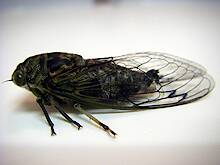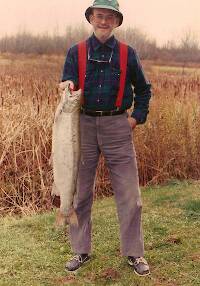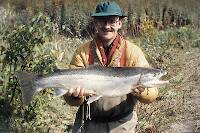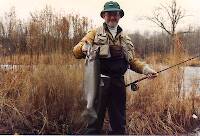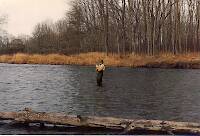
Blue-winged Olives
Baetis
Tiny Baetis mayflies are perhaps the most commonly encountered and imitated by anglers on all American trout streams due to their great abundance, widespread distribution, and trout-friendly emergence habits.
Featured on the forum

This specimen appears to be of the same species as this one collected in the same spot two months earlier. The identification of both is tentative. This one suffered some physical damage before being photographed, too, so the colors aren't totally natural. I was mostly photographing it to test out some new camera setting idea, which worked really well for a couple of closeups.

Troutnut is a project started in 2003 by salmonid ecologist Jason "Troutnut" Neuswanger to help anglers and
fly tyers unabashedly embrace the entomological side of the sport. Learn more about Troutnut or
support the project for an enhanced experience here.
Sbman07 on Jan 5, 2008January 5th, 2008, 7:26 am EST
Just wondering if the color of the fly line really matters. One reason is that this really is the first time where I had extra spools that i brought with me. I dont want to spend $70 on a line that I rarely use however all the cheaper line I have seen has been really bright colors and wasnt sure if that really made a difference all that much. and do you prefer the WF vs. DT or vica versa
Three things I am never late for church, work, and fishing.
CaseyP on Jan 5, 2008January 5th, 2008, 9:14 am EST
here is a thread about lines/color.
http://www.troutnut.com/topic/978
near the bottom of that thread is a link to a discussion of trout vision.
my take is that a colorful line can be seen much more readily as it flicks over the stream, and therefore can startle the fish more. grey and olive don't show as readily, IMHO. for delicacy, DT all the way.
http://www.troutnut.com/topic/978
near the bottom of that thread is a link to a discussion of trout vision.
my take is that a colorful line can be seen much more readily as it flicks over the stream, and therefore can startle the fish more. grey and olive don't show as readily, IMHO. for delicacy, DT all the way.
"You can observe a lot by watching." Yogi Berra
Martinlf on Jan 5, 2008January 5th, 2008, 11:33 am EST
I've been using olive and grey lines for a while, and feel this may give an edge, especially on spring creeks. I like DT for smaller streams, and WF for bigger water, especially if some distance is needed at times.
"He spread them a yard and a half. 'And every one that got away is this big.'"
--Fred Chappell
--Fred Chappell
Sbman07 on Jan 5, 2008January 5th, 2008, 1:37 pm EST
thanks for the reply and the discussion forum number and your opinions.
Three things I am never late for church, work, and fishing.
Flybinder on Jan 9, 2008January 9th, 2008, 12:04 pm EST
You mention "cheaper lines, but brightly colored".
Fortunately, that's not a real problem. I've found a lot of lines, on sale, on closeouts, discontinued, etc. and like you said.............. they're usually bright orange, flour.yellow, etc.
However, if the price is decent enough, I'll buy the line anyway, (and, if it's a line, worth the price) then simply die it to a more subdued coloring. Unless, your competitive casting, or you just like to throw 90' of line, for your average fishing you only need to die the first 30 to 40 feet of line......not the entire thing.
I've been lucky to find a lot of my fly lines on sale, then merely change their color, to something more "fishable".
Fortunately, that's not a real problem. I've found a lot of lines, on sale, on closeouts, discontinued, etc. and like you said.............. they're usually bright orange, flour.yellow, etc.
However, if the price is decent enough, I'll buy the line anyway, (and, if it's a line, worth the price) then simply die it to a more subdued coloring. Unless, your competitive casting, or you just like to throw 90' of line, for your average fishing you only need to die the first 30 to 40 feet of line......not the entire thing.
I've been lucky to find a lot of my fly lines on sale, then merely change their color, to something more "fishable".
Flybinder:
"You should'a been here, NEXT week,the fishing's great!"
"You should'a been here, NEXT week,the fishing's great!"
DayTripper on Jan 9, 2008January 9th, 2008, 11:51 pm EST
Flybinder- What are you using to dye your lines with? I've wanted to do this for a while, but have been afraid to damage the coating.
Martinlf on Jan 10, 2008January 10th, 2008, 1:07 am EST
See the thread that Casey posts a link for above. Click on the link for a description of fly line dyeing.
"He spread them a yard and a half. 'And every one that got away is this big.'"
--Fred Chappell
--Fred Chappell
Dano on Jan 10, 2008January 10th, 2008, 1:38 am EST
Steve,
In my experience (nearly 40 years) in fly fishing I'd say line color is of no consequence. Nor would I equate line color with line quality. I've been fishing with SA (Ultra series) lines almost exclusively since I first started. I've always perferred their "buckskin" color only because their "sunrise" seemed too gaudy. However, I was in the position a few years back of having to go with a Mastery Series WF-4-F in "optic orange" (no buckskin in stock and didn't want to wait for a special order).
In reviewing my fishing logs since the purchase of that line, I see no impact resulting from changing colors. My "home stream", the Williamson, is gin clear and the stretch I fish most probably averages 2-3' deep.
So, I'm more inclined to believe that shadows cast by a line in the air and any "disturbance" by it's landing on the water are the two most likely causes for "lining" a fish.
As to taper preferance, much depends on the conditions. Personally, I prefer a DT because it will present the fly more delicately than a WF. In my neck o' the woods the wind really kicks up by mid morning, so I'll switch to the WF until it dies down. When the hatch ends, I'll more than likely go to the WF sinking tip to fish nymphs, wets, and/or streamers...FWIW.
Dano
In my experience (nearly 40 years) in fly fishing I'd say line color is of no consequence. Nor would I equate line color with line quality. I've been fishing with SA (Ultra series) lines almost exclusively since I first started. I've always perferred their "buckskin" color only because their "sunrise" seemed too gaudy. However, I was in the position a few years back of having to go with a Mastery Series WF-4-F in "optic orange" (no buckskin in stock and didn't want to wait for a special order).
In reviewing my fishing logs since the purchase of that line, I see no impact resulting from changing colors. My "home stream", the Williamson, is gin clear and the stretch I fish most probably averages 2-3' deep.
So, I'm more inclined to believe that shadows cast by a line in the air and any "disturbance" by it's landing on the water are the two most likely causes for "lining" a fish.
As to taper preferance, much depends on the conditions. Personally, I prefer a DT because it will present the fly more delicately than a WF. In my neck o' the woods the wind really kicks up by mid morning, so I'll switch to the WF until it dies down. When the hatch ends, I'll more than likely go to the WF sinking tip to fish nymphs, wets, and/or streamers...FWIW.
Dano
Martinlf on Jan 10, 2008January 10th, 2008, 8:29 am EST
Dano, I don't know about this for sure, but some seem to believe that bright orange flashing in the air is more visible than a more dull color. I doubt it would make much difference, if any, in most of my fishing, but I'm not sure color is of no consequence in all situations.
"He spread them a yard and a half. 'And every one that got away is this big.'"
--Fred Chappell
--Fred Chappell
Flybinder on Jan 10, 2008January 10th, 2008, 12:28 pm EST
Daytripper;
I use regular old "Rit" dye, for my fly lines and I make sure, when mixing the dye to have the water reach boiling, before adding the dye to it.
Most and Rit especially, won't release all their acids, (needed to set the dye properly and to get the color you're after), unless stirred into boiling water. It WILL dissolve and color your like, to an extent, in cooler water, but NOT as well as it will if the water's boiling.
Anyhoo, here's a link with the procedure I use..............
http://www.iffa.org.uk/dyinglines.htm
I use regular old "Rit" dye, for my fly lines and I make sure, when mixing the dye to have the water reach boiling, before adding the dye to it.
Most and Rit especially, won't release all their acids, (needed to set the dye properly and to get the color you're after), unless stirred into boiling water. It WILL dissolve and color your like, to an extent, in cooler water, but NOT as well as it will if the water's boiling.
Anyhoo, here's a link with the procedure I use..............
http://www.iffa.org.uk/dyinglines.htm
Flybinder:
"You should'a been here, NEXT week,the fishing's great!"
"You should'a been here, NEXT week,the fishing's great!"
Martinlf on Jan 11, 2008January 11th, 2008, 12:26 am EST
Interesting. I'll add that I've dyed small batches of fur and feathers in a canning jar, heating the dye bath in the microwave before adding materials, a few times. It's quick and easy, but don't let it boil over. After I fish out the materials, I put a canning lid on and save the dye for another job later.
"He spread them a yard and a half. 'And every one that got away is this big.'"
--Fred Chappell
--Fred Chappell
Dano on Jan 11, 2008January 11th, 2008, 12:54 am EST
...some seem to believe that bright orange flashing in the air is more visible than a more dull color.
Well Louis, I'm certain that some do believe that to be true judging from what's been said in the links CaseP mentioned....I, however, don't, at least as far as the fish are concerned.
Ever been snorkeling or skin diving? Are you aware of how a fish's cone of vision works? And lastly, do you recall your junior high science lessons on light refraction?
As I mentioned above, my records don't indicate a "negative" impact by going with optic orange...
Dano
Well Louis, I'm certain that some do believe that to be true judging from what's been said in the links CaseP mentioned....I, however, don't, at least as far as the fish are concerned.
Ever been snorkeling or skin diving? Are you aware of how a fish's cone of vision works? And lastly, do you recall your junior high science lessons on light refraction?
As I mentioned above, my records don't indicate a "negative" impact by going with optic orange...
Dano
Falsifly on Jan 11, 2008January 11th, 2008, 6:22 am EST
The results of a study done on this question can be found here.
http://books.google.com/books?id=ZaqO1wDJHi8C&dq=%22understanding+trout+behavior%22
Unfortunately pages 125-130 which deal specifically with fly lines is not included in the book preview. There is also a section describing and explaining “Snell’s Circle” something I had not heard of until obtaining this book. Some of you may want to consider adding this book to your library.
http://books.google.com/books?id=ZaqO1wDJHi8C&dq=%22understanding+trout+behavior%22
Unfortunately pages 125-130 which deal specifically with fly lines is not included in the book preview. There is also a section describing and explaining “Snell’s Circle” something I had not heard of until obtaining this book. Some of you may want to consider adding this book to your library.
Falsifly
When asked what I just caught that monster on I showed him. He put on his magnifiers and said, "I can't believe they can see that."
When asked what I just caught that monster on I showed him. He put on his magnifiers and said, "I can't believe they can see that."
Krachen on Jan 11, 2008January 11th, 2008, 6:36 am EST
I fish with the SA trout lines in olive...i too think that a bright line is not a good thing HOWEVER...I do fish ALOT during the evening, and after dark, and although afterdark it doesnt much matter...when you are fishing on big rivers (the delaware) and have an olive line...it is a real B#%#* to gauge where your line is. When you are fishing small flies at dusk and making long casts wher eyou cant see your fly, it really sucks when you also have a dull fly line that is nearly impossible to see...just a thought you might want to consider...
CaseyP on Jan 11, 2008January 11th, 2008, 12:52 pm EST
oh, rats. here i swore not to buy any more lines or spools...you are absolutely right--dusk is hard, hard, hard. of course, if you cast like i do, you have a wonderful effect of line hitting smooth water that is poetic (and visible!) at dusk.
"You can observe a lot by watching." Yogi Berra
Dano on Jan 12, 2008January 12th, 2008, 4:45 am EST

A below average Brown (5.5 lbs), average last season on the Williamson was 5.75lbs. This one was caught on the third cast with a #14 Blue Dun (wet) tied to a 9' 3x tippet. Out of over 60 Browns caught on this stretch
 ,
, more than a third were caught using the WF 4 F optic orange line shown. The other two thirds were caught using a DT (ivory) and sinking tip (peach) lines.
Does this prove anything? Nope. But, at least shows why I don't concern myself with line color. FWIW.
Dano
Martinlf on Jan 12, 2008January 12th, 2008, 5:10 am EST
Nice fish, Dano. At least it didn't mind the orange line. ;>
"He spread them a yard and a half. 'And every one that got away is this big.'"
--Fred Chappell
--Fred Chappell
Sbman07 on Jan 12, 2008January 12th, 2008, 3:13 pm EST
Hey Dano,
Thanks for the info nice pictures by the way. I did end up getting the optic green with the willow tip and it seems to be fine, I've caught fish before on yellow and bright green and i didnt know if i could catch more if i switch to a dull color.
Thanks for the info nice pictures by the way. I did end up getting the optic green with the willow tip and it seems to be fine, I've caught fish before on yellow and bright green and i didnt know if i could catch more if i switch to a dull color.
Three things I am never late for church, work, and fishing.
Dano on Jan 13, 2008January 13th, 2008, 4:25 am EST
Louis,
Thanks and no it didn't...
Steve,
No problemo...In fly angling a positive attitude goes a very long way, IMNSHO. Having confidence in one's tackle and flies helps as well.
Someone mentioned that the brighter colored lines are a real help durning dawn and dusk, "gauge" I believe is the word used, which is the operative word in his statement. With 7.5' to 12.5' leaders under those conditions, one would have to have the eyesight of an owl to see precisely where their #14 Red Quill is. Over time, you'll develop a "sixth sense" to know where your fly is and when to strike...
In Oregon fishing for trout is legal only from an hour before sunrise to an hour after sunset so rarely will I go shorter than a 9' leader. When I was back in Michigan, 7.5' leaders were the "rule" when night fishing...I sorely miss not being able to night fish anymore.
Dano
Thanks and no it didn't...
Steve,
No problemo...In fly angling a positive attitude goes a very long way, IMNSHO. Having confidence in one's tackle and flies helps as well.
Someone mentioned that the brighter colored lines are a real help durning dawn and dusk, "gauge" I believe is the word used, which is the operative word in his statement. With 7.5' to 12.5' leaders under those conditions, one would have to have the eyesight of an owl to see precisely where their #14 Red Quill is. Over time, you'll develop a "sixth sense" to know where your fly is and when to strike...
In Oregon fishing for trout is legal only from an hour before sunrise to an hour after sunset so rarely will I go shorter than a 9' leader. When I was back in Michigan, 7.5' leaders were the "rule" when night fishing...I sorely miss not being able to night fish anymore.
Dano
DayTripper on Jan 17, 2008January 17th, 2008, 2:55 am EST
Thanks for the links regarding dying. I don't think I'll dye thewhole line, maybe just the first 15'-20'
Quick Reply
Related Discussions
Topic
Replies
Last Reply
2
May 17, 2018
by Subway
by Subway




